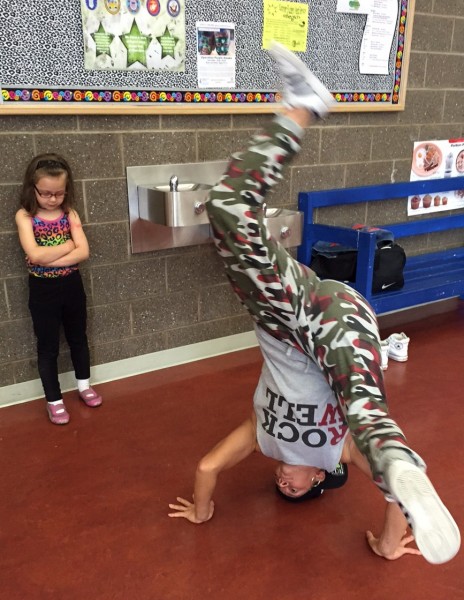
Hip Hop is more than just music and dancing; it’s a culture based on bringing people together. That was the message during this weekend’s All Tribes Hip Hop Cultural Heritage Summit at Begich Middle School in East Anchorage.
Local break dancer Brianna McMillen is surrounded by an eager group of elementary school students who are spinning on their backs and standing on their heads. Camo sweatpants hang from her petite but powerful frame, baseball hat askew on her head. She’s providing an impromptu dance lesson.
“I want you to move your foot there… Then do this,” she says while demonstrating an awkward crab-like walk.
McMillen, aka Bgirl Snap1, started listening to hip hop as teenager at South High in Anchorage.
“I could relate it to an adrenal rush on nice sunny day,” she says of listening to hip hop. “Just that rush of good feeling and just like that breathe of fresh air that life is really good.”
But she says at 16, she couldn’t really express what she felt physically.
“I loved music, but I never felt very rhythmically coordinated. I was more of an athlete more than anything. I didn’t know how to dance. And when I saw breaking I saw all the athleticism in it, and all the crazy moves that they were doing. And they were still dancing to the music that was just catching my ear.”
McMillen says through breaking, she met kids from all over town and from a variety of different backgrounds. She soon learned that hip hop isn’t just creativity, it’s self-discipline. She’s using that skill as a Blackhawk mechanic with the National Guard. She says hip hop is also about understanding that people are all just people.
Summit organizer and hip hop artist George Martinez explains that hip hop was created in New York in the 1970s as a way to unify people.
“Because fundamentally it was a group of people who are unlikelies – the write-offs, people who were poor, the people of color in the South Bronx who everyone forgot about who decided that just with cardboard boxes, they could transform a sidewalk into a dance studio and give each other hope.”
Martinez says hip hop values are peace, knowledge, and having fun. The culture gives people tools to compete and air their differences through non-violent, creative means. He says underground battles are happening all the time in Anchorage to see who raps better or dances better.
Samuel Johns grew up in Copper Center living a traditional lifestyle of hunting and fishing with his family. But he also listened to a lot of Tupac. He told the crowd of 40 youth and community members that it was Tupac’s storytelling through music that taught him how to connect to older generations. Now he’s known as AK Rebel and raps about ending domestic abuse and other violence.
“When I make music, I make music that will be remembered 10 years from now because it meant something. Because it’s a real story. It’s not just something that’s meant for clubs; it’s not just something that people dance to.”

Outside of the school, tall white wooden boards lean against a lamppost – temporarily blank canvases. Fourteen-year-old Kwali Phillips shakes a can of spray paint. He’s learning about another element of hip hop, graffiti art, as he reflects on the messages he learned from different rappers.
“Just to be true to myself and don’t make an impersonation of somebody. Not to portray myself in a negative light,” he says.
12-year-old Layla Kremer says the music and the dancing unite the kids at Begich Middle School.
“If, like, a new dance comes out, like all the kids are doing it. Everybody’s doing it. Like with the Whip, Lil’ Einstein’s music. Like I’ve seen white people, black people, African-Americans, Chinese. All just hanging out and doing the exact same dance just hanging out. It brings us all closer together.”
She grabs some paint and leans over a friend to add her mark to the board.
Anne Hillman is the healthy communities editor at Alaska Public Media and a host of Hometown, Alaska. Reach her atahillman@alaskapublic.org. Read more about Annehere.





